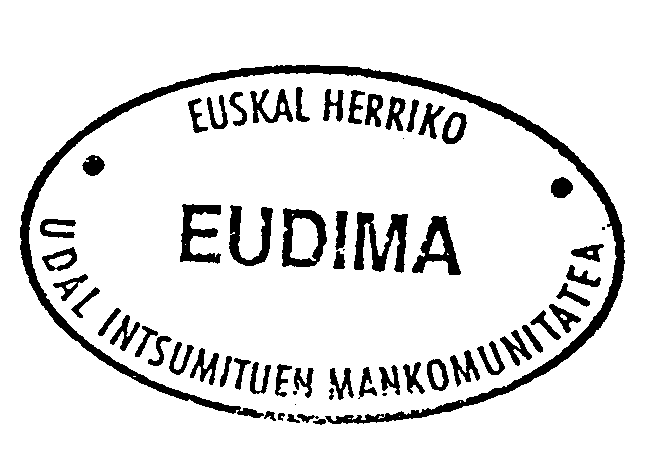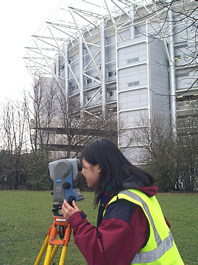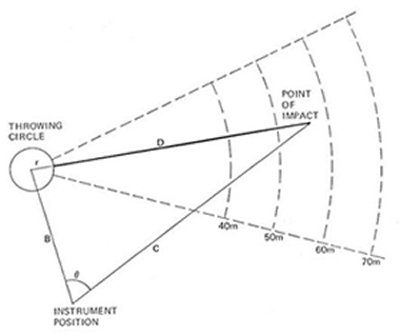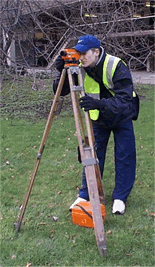SPAN CLASSSECTIONTEACHING RESOURCESSPAN TBODYTBODY!BEGIN FOOTER NAV TBODY SPAN
SPAN CLASSSECTIONTEACHING RESOURCESSPAN TBODYTBODY!BEGIN FOOTER NAV TBODY SPAN
Teaching Resources - Geomatics.org.uk

|
Teaching Resources Mathematics | Athletics Have you ever wondered how the thrown distance is measured in the javelin, discus or hammer events at the Olympic Games when there is not a tape measure in sight? athletics stadium >> |
|
|
|
Dr Jon Mills | 2001 |
Traditionally these distances were measured by a conventional direct method using a steel tape. However, the need to increase speed and reliability of the measurements, and to reduce the number of officials close to the throwing area, led to the development of a method where the distances are determined indirectly from a combination of distances and directions measured electronically. At the heart of the method is an instrument known as a total station (pictured), which is capable of measuring both angles and distances. It is positioned so that the person operating the instrument has a good view of the entire throwing area. Prior to the start of the event, the relevant positions of the centre of the throwing circle and the instrument are measured and stored in a computer. After each throw, the point of impact is marked with a reflector and is sighted using the telescope of the instrument. << total station The instrument then measures the slope distance and horizontal and vertical directions to the reflector. From these measurements and the stored data, the on-line computer computes the distance thrown. The whole process typically takes 15-20 seconds. |
|
|
Calculation The equation used to determine the distance thrown is given below:
Where:
>> A diagram of the distances and angles used in the calculation |
|
|
Example calculation Determine the distance thrown when the following information has been recorded for a discus thrower: Information about the throwing circle Throwing circle for discus has a diameter of 2.50 m Positional
data, instrument position to centre of throwing circle: Positional
data, instrument position to point of impact: Solution First need to determine the horizontal distances from the instrument to the centre of the throwing circle and to the point of impact. This is achieved using the vertical angle and slope distance: Horizontal distance = slope distance x cosine of the vertical angle (from horizontal) For
the circle: For
the point of impact: Now need to use the following equation given to compute the distance thrown:
Where:
|
|
|
Further teaching resources You can modify the raw data (slope distance, horizontal and vertical angles) to produce different solutions. If the students have not been taught degrees, minutes and seconds, simplify the angle reading to decimal degrees. The other parameter, the circle radius, will be different for other events (except the hammer, which uses the same circle). Remember to keep the answer sensible: the Men's World Record for discus is 74.08 m, thrown by Jurgen Schult of Germany in 1986; the Women's World Record is held by Gabriele Reinsch, also of Germany, who threw 76.80 m in 1988. You could also add additional data to determine whether or not the throw was legal or not. The discus is thrown from the circle into a sector of angle 40 degrees. If it lands outside this sector the throw is illegal. By providing data about the throwing circle/sector orientation, the student could determine whether or not the discus had landed in this sector. Rules on the discus can be found http://www.coolrunning.com.au/hclac/official/discus.html. Do
you want to make measurements for real? If so, we would be
delighted to attend your school's sports day with a total station
instrument that the students could use themselves and provide data
for your mathematics classes. Dr Jon Mills, Dept. Geomatics at Newcastle | 2001 |
|
|
Ideas | Sports measurement Have you ever wondered how the thrown distance is measured in the javelin, discus or hammer events at the Olympic Games when there is not a tape measure in sight? athletics stadium >> Traditionally these distances were measured by a conventional direct method using a steel tape. However, the need to increase speed and reliability of the measurements, and to reduce the number of officials close to the throwing area, led to the development of a method where the distances are determined indirectly from a combination of distances and directions measured electronically. |
|
|
|
|
At the heart of the method is an instrument known as a total station (pictured), which is capable of measuring both angles and distances. It is positioned so that the person operating the instrument has a good view of the entire throwing area.
Prior
to the start of the event, the relevant positions of the centre of
the throwing circle and the instrument are measured. After each
throw, the point of impact is marked with staff and is sighted
using the telescope of the instrument.
rw | Monday, August 19, 2002 |
|
||
Calculation
|
In
this diagram: |
|
|
Example
Calculation
Information
about the throwing circle Positional
data, instrument position to centre of throwing circle: |
|
|
Positional
data, instrument position to point of impact: Solution We need to use the following equation given to compute the distance thrown:
Where: If the students have not been taught degrees, minutes and seconds, simplify the angle reading to decimal degrees. The other parameter, the circle radius, will be different for other events (except the hammer, which uses the same circle). |
|
Exercise is based on notes written by Dr Jon Mills, Dept. Geomatics | Monday, August 19, 2002
Ideas | Error measurement
As a follow on from the sports measurement exercise, why not look at how errors in your measurements could affect the final results?
Question:
If the horizontal angle reading is incorrect by one degree, how much is the calculated distance affected?
Where:
D
is the distance thrown
B
is the horizontal distance between the instrument and the centre of
the throwing circle
C
is the horizontal distance between the instrument and the point of
impact
![]() is
the horizontal angle between the centre of the throwing circle and
the point of impact.
is
the horizontal angle between the centre of the throwing circle and
the point of impact.
r is the radius of the throwing circle
The equation needed is:
![]()
|
Example solution:
Where:
|
Or using
The difference between the two is 1.60m! This exercise demonstrates the importance of accuracy when taking measurements. |
rw & Megan Gilliard| Monday, August 19, 2002
Tags: resourcesspan, classsectionteaching, tbodytbody!begin, footer, tbody
- ZAŁĄCZNIK NR 1 DO UCHWAŁY NR XXIV17212 RADY GMINY
- PRÉFET DE L’EURE ARRÊTÉ N°D1B2PC17001 PORTANT FIXATION DES
- [PROGRAMIN ADI] TR XXXXXXXXXX NO’LU PROJESİ AVRUPA
- VERDAL KOMMUNE TIL LOKAL STYRINGSGRUPPE KOMMUNEREFORMEN DERE BLIR MED
- GUIDELINES FOR ACCESSIBILITY AND REASONABLE ACCOMMODATIONS FOR PERSONS WITH
- PASQUOTANK COUNTY NORTH CAROLINA MAY 6 2021 THE PASQUOTANK
- MINISTERIO DE TRANSPORTE AGENCIA NACIONAL DE SEGURIDAD VIAL “2016
- WYCHOWANIE DO KORZYSTANIA Z MEDIÓW JAKO ZADANIE SPOŁECZNE I
- A CARER’S ASSESSMENT IN BUCKINGHAMSHIRE A CARER IS “A
- D ESAYUNO BREAKFAST E SPECIALIDADES DE LA CASA
- DR MARCELO E CHAÍN H CÁMARA DE DIPUTADOS PROVINCIA
- CONTRATO DE COMISIÓN MERCANTIL QUE CELEBRAN POR UNA PARTE
- UNIVERSITY OF NORTH CAROLINA SCHOOL OF NURSING SIMULATION CONFIDENTIALITY
- NOMBRE DE LA ACTIVIDAD ENCUESTA PREVIA A LA ACTIVIDAD
- I WORKSHOP REDETB (REDE BRASILEIRA DE PESQUISA EM TUBERCULOSE)
- NO13953PP II9619 GOVERNMENT OF PUNJAB DEPARTMENT OF PERSONNEL AND
- PÉTANQUE – TŘEBÍČ OPEN 11 ROČNÍK „VO JARINOVY KOULE“
- XAVIER CHIRON MERCI BEAUCOUP MONSIEUR LE DIRECTEUR GÉNÉRAL MONSIEUR
- CLI SPECIAL DIRECTIVES PRINT CLI VERSION
- SOLICITUD DE AUTORIZACIÓN PROVISIONAL DE APERTURA DE ESTABLECIMIENTO ESPECIALIZADO
- LUIS LANZ TIENDA MARCH 12 2007 AE120 – CITY
- 31 RAPPORT DE LATELIER SUR LA FIXATION
- AASD AND DSD ELIST ANNOUNCEMENT DATE MARCH 14 2019
- JUSTIFICACIÓN DE LA UNIDAD DIDÁCTICA LA LECTURA OFRECE PEQUEÑOS
- BUCKINGHAMSHIRE COUNTY LADIES GOLF ASSOCIATION GERRARDS CROSS
- PETITIONS TO ACCEPT UNINTENTIONALLY DELAYED PAYMENT OF A MAINTENANCE
- PÁZMÁNY PÉTER KATOLIKUS EGYETEM JOG ÉS ÁLLAMTUDOMÁNYI KAR BÜNTETŐ
- CARTA PARA PRESENTACIÓN DE LA OFERTA [BOGOTÁ DC XX
- WORKSHOP IDENTIFYING GAPS BETWEEN HCI SOFTWARE ENGINEERING AND DESIGN
- PATIENTENDATENDATUM [PRAXISNAMELOGO] FB XXX ALLERGIEFRAGEBOGEN NACH SITSLIT SEHR GEEHRTER
SINTAXIS LA ORACIÓN COMPUESTA CLASIFICACIÓN DE LA ORACIÓN COMPUESTA
 INVITACIÓN LA FUNDACIÓN CONAMA CONGRESO NACIONAL DEL MEDIO AMBIENTE
INVITACIÓN LA FUNDACIÓN CONAMA CONGRESO NACIONAL DEL MEDIO AMBIENTE UT 8 LA GESTIÓN DE LOS CADÁVERES LA GESTIÓN
UT 8 LA GESTIÓN DE LOS CADÁVERES LA GESTIÓNCATCHING SUNSHINE WHAT MATERIALS DO I NEED? COMPUTER EQUIPMENT
 ESTATUTOS DE LA MANCOMUNIDAD DE AYUNTAMIENTOS INSUMISOS VASCOS CAPITULO
ESTATUTOS DE LA MANCOMUNIDAD DE AYUNTAMIENTOS INSUMISOS VASCOS CAPITULO INFOHEFTE TIL STUDENTER I SANDVIKVEIEN BARNEHAGE VELKOMMEN TIL OSS!
INFOHEFTE TIL STUDENTER I SANDVIKVEIEN BARNEHAGE VELKOMMEN TIL OSS!RPG NEW PLAYER INTERVIEW NAME AGE ROLEPLAYING GAME EXPERIENCE
ING JIŘÍ DOLEŽEL VZDĚLÁVACÍ INSTITUCE AKREDITOVANÁ MV ČR
 STO RESTORE SPECIFICATION FOR REPAIR OF EXTERIOR INSULATION AND
STO RESTORE SPECIFICATION FOR REPAIR OF EXTERIOR INSULATION AND CARNET AMIGOS DEL TEATRO SALÓN CERVANTES NOMBRE APELLIDOS TELÉFONO
CARNET AMIGOS DEL TEATRO SALÓN CERVANTES NOMBRE APELLIDOS TELÉFONOPODATKE VPISUJTE S TISKANIMI ČRKAMI PRED IZPOLNJEVANJEM OBVEZNO PREBERITE
KLAUZULA INFORMACYJNA DLA CZŁONKÓW ZARZĄDU WE WSPÓLNOCIE MIESZKANIOWEJ INFORMACJE
 OPERATING PROCEDURES OF THE ANSI CAPC (CONFORMITY ASSESSMENT POLICY
OPERATING PROCEDURES OF THE ANSI CAPC (CONFORMITY ASSESSMENT POLICYENDING SEGREGATION – INCLUSIVE EDUCATION FOR ALL CHILDREN UN
 18 COTIZACIÓN PÚBLICA NO CGC072009 IMPRESION DE FORMAS OFICIALES
18 COTIZACIÓN PÚBLICA NO CGC072009 IMPRESION DE FORMAS OFICIALESSTUDENT VISA (FOR A PERIOD OF STAY IN SPAIN
 GAP KAPSAMINDA YAPILAN ARAZİ TOPLULAŞTIRMA ÇALIŞMALARI UĞUR BÜYÜKHATİPOĞLU BÖLGE
GAP KAPSAMINDA YAPILAN ARAZİ TOPLULAŞTIRMA ÇALIŞMALARI UĞUR BÜYÜKHATİPOĞLU BÖLGE Application for Employment an Equal Opportunity Employer (application Will
Application for Employment an Equal Opportunity Employer (application WillAGENDA ZONING BOARD OF APPEALS – REGULAR MEETING TUESDAY
 POWERPLUSWATERMARKOBJECT6755375 “SURCANDO EL PANTANO DE LA DEMOCRACIA EN MÉXICO”
POWERPLUSWATERMARKOBJECT6755375 “SURCANDO EL PANTANO DE LA DEMOCRACIA EN MÉXICO”



